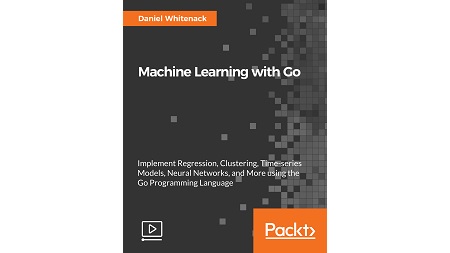
English | MP4 | AVC 1920×1080 | AAC 44KHz 2ch | 2h 48m | 706 MB
Build simple, maintainable, and easy to deploy machine learning applications
The mission of this course is to turn you into a productive, innovative data analyst who can leverage Go to build robust and valuable applications. To this end, the course clearly introduces the technical aspects of building predictive models in Go, but also helps you understand how machine learning workflows are applied in real-world scenarios.
This course shows you how to be productive in machine learning while also producing applications that maintain a high level of integrity. It also gives you patterns to overcome challenges that are often encountered when trying to integrate machine learning in an engineering organization.
You’ll begin by gaining a solid understanding of how to gather, organize, and parse real-work data from a variety of sources. Then you’ll develop a solid statistical toolkit that will allow you to quickly understand gain intuition about the content of a dataset. Finally, you’ll gain hands-on experience of implementing essential machine learning techniques (regression, classification, clustering, and so on) with the relevant Go packages.
By the end, you’ll have a solid machine learning mindset and a powerful Go toolkit of techniques, packages, and example implementations
This course connects the fundamental, theoretical concepts behind Machine Learning to practical implementations using the Go programming language. It will give you the practical skills to perform the most common machine learning tasks with Go.
What You Will Learn
- Find out about data gathering, organization, parsing, and cleaning
- Explore matrices, linear algebra, statistics, and probability
- See how to evaluate and validate models
- Look at regression, classification, clustering
- Find out about neural networks and deep learning
- Utilize times series models and anomaly detection
- Get to grip with techniques for deploying and distributing analyses and models
- Optimize machine learning workflow techniques
Table of Contents
01 The Course Overview
02 Handling Data
03 CSV Files
04 JSON
05 SQL-like Databases
06 Caching
07 Matrices and Vectors
08 Statistics
09 Probability
10 Evaluation
11 Validation
12 Linear Regression
13 Multiple Linear Regression
14 Nonlinear and Other Types of Regression
15 Logistic Regression
16 k-Nearest Neighbors
17 Decision Trees
18 Understanding Clustering
19 k-Means Clustering
20 Representing Time Series Data in Go
21 Statistics Related to Time Series
22 Auto-Regressive Models
23 Understanding Neural Net Jargon
24 Utilizing the Simple Neural Network
25 Docker-izing the Model
26 Docker-izing Model Predictions
Resolve the captcha to access the links!